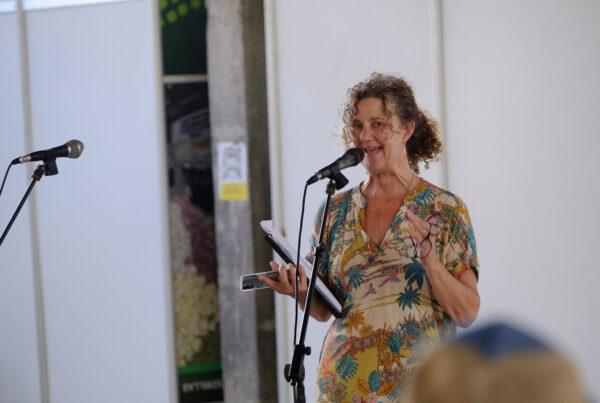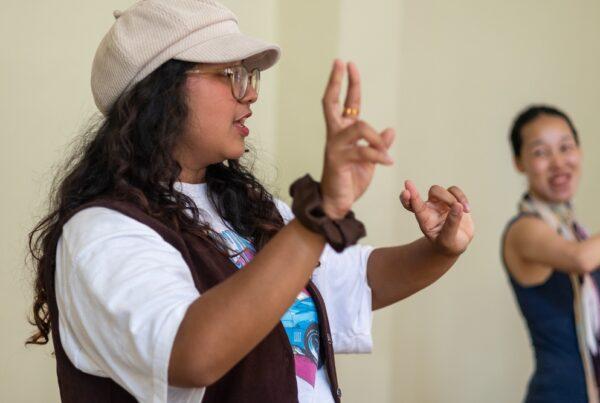Kelly Freebody and Michael Anderson, both professors at the University of Sidney, are at the ASSITEJ Artistic Gathering to present their work as they research the value of Theatre for Young Audiences (TYA). But what’s more significant perhaps, is that they’re using the occasion to further their research; grasping the opportunity to collect ‘grey literature’, as they say, or in other words, data that has been collected in the field as opposed to the literature review which they have already collated.
Delving into finding out what their research is all about, Freebody is quick to answer with a question. “Why do we do the work that we do, and why do we think it matters?,” says Freebody.
“What are the stories we tell ourselves (both adults and young people) about youth theatre,” adds Anderson, “some of the stories we tell ourselves are that TYA is good for kid’s mental health, or that it’s good for young people’s confidence, or that it’s good for community building,” he says.
That’s the purpose of their research: Collated evidence on the value of TYA that curates and synthesises the existing research from across the field. To this end, the primary focus of the research is on knowledge synthesis – collecting, curating, and signposting to pre-existing published literature, as well as grey (unpublished) literature, that qualifies and quantifies claims on the value of theatre and performing arts for children.
“I think that there’s often a disconnect between the stories we tell ourselves about the importance of our work as practitioners, and what funding bodies, governments, schools, and the world knows about our work, and what our work’s impact really is,” defines Freebody.
“In this sense, our job is really simple,” adds Anderson. “It’s about finding out everything that talks about the evidence for the stories we tell ourselves, and present that back to ASSITEJ members, in order to be in a position to say: this is what we know from the evidence, and here are the gaps in the evidence.”

Both highlight the importance of gathering that evidence and accentuate that if practitioners are going to have discussions with governments, policymakers or funders, they need to have evidence that speaks to those people, as well as evidence that speaks to their own selves, because this evidence will actually help in defining, first of all, what their work is actually achieving and understand how they can make their practice more effective. “(Having this evidence means that) we can have discussions with parents and young people and other theatre makers and speak from the same evidence base,” says Freebody, “and that’s a very valuable thing for a field on youth theatre”.
The first step into this research is about systematic literature review. “This is a massive search to see what’s out there. And we’re being very specific when searching. We want our research to be in theatre, with young people, from around the world, and it has gather some kind of evidence of impact from a young person, it can’t just be about what adults say about the work they’re doing,” clarifies Freebody.
“We’ve done the big search of academic papers, we’ve got graphs that talk about what we’ve found,” she adds. “The next thing and this is why we’re here in Serbia too, is to say that’s fine, that’s what all of the academic scholarly literature says, but everybody here (at the ASSITEJ Artistic Gathering 2023) has evaluations in the bottom of their drawers that have never been published, what’s in those, what do they say?” reveals Freebody.
“We’re trying to gather data from the field, because things get published in the scholarly realm which is for specific audiences. We know things about our practice that we sometimes have evidence for, but sometimes we don’t. So we’re trying to gather what we call ‘grey literature’, from people themselves; things that are in desk drawers or in folders, or evaluations that practitioners have done for funding purposes but never got published,” she adds.
At this year’s Artistic Gathering, the duo aspires to talk to people and do focus groups and interviews in order to gather data. “And from that we’re going to try and produce a document that will help the field for two core reasons: for one, to know our work better; know why it works and how it works. And for two, to be able to speak to funders, government or policy makers with evidence,” says Freebody.
Another aspect the duo will strive to accomplish once the data is collected is an evidence gap map that will include both literature review and grey literature. “This map will then bring all evidence together. “The stories that we tell about youth mental health, for example. We tell this story; it’s a profound and enduring story about why our work matters. It’s good for the well-being and mental health of young people. But we don’t have any evidence, or we have very little evidence,” says Freebody.
“We have evidence that we see in practice, in our own theatres, but it’s our qualitative experience, which is valid,” adds Anderson, “but how do we put evidence behind that? So this map will help us when someone says, prove it, or where’s your evidence, we will have evidence that can back up how we feel or what we see in or about our practice.”
Foreseeing the challenges that may be faced as they delve further into their research, Freebody and Anderson can already identify three challenges.
“One of the challenges is literature, or research or evidence that is not available in English. Anything that people know of, even scholarly work in Spanish or Portuguese or Norwegian is really important. ASSITEJ membership sometimes knows about things that we’ve never heard of, quite substantial pieces of research, because they haven’t been published in English and their hard for us to find,” says Anderson. That’s another aspect of what they are hoping to get their hands on and translate into English.
“I think that there’s also challenges around the types of interventions that we often do, and I don’t necessarily know if this is a problem, but it’s something we need to think about: we don’t do randomised control trials, for example. In our field, we don’t tend to do these things. And so what we’re finding is that there are a lot of people talking about health outcomes for example, as an impact. But it’s sort of clinical. So it tends to be more qualitative health education or things like that. So I think that there’s potentially work that’s falling through the cracks,” says Freebody, “So that’s going to be a challenge for the field generally and for us, with regards to how we think about our work.”

“There’s another challenge, which is work reported by young people, not just adults talking young people,” says Anderson. “In this research, we need to hear young people talking about the work rather than adults talking about young people in the work,” he adds.
“But it’s very exciting because what we’ve got the privilege of doing this research and the honour of looking at all of the work in this field, and we’re just trying to understand it and bring it together into something coherent. We hope to provide it in a fairly plain language form; we’re not thinking this is going to be an article that will be maybe two or three pages long, it’s about giving people access to what we know and where the gaps are. So it’ll be a bit like a map. We’ll know the territory that we’ve covered and we’ll know where we need to go and seek for more, and in that sense, I think could be quite helpful,” concludes Anderson.
From her perspective, Freebody estimates that the work that they have started will continue to grow. “We’ve registered the research with Corporate which is a local (Australian) company that produces systematic research and there is a series of processes we had to go through for the registration of the research project, which means that it’s from a global research community and considered as a trusted piece of research, which makes it more useful for practitioners to use. But we’re also using a programme that we can just keep adding to as documents come in, so that we can continue to map the field.”
Freebody and Anderson’s research on value of TYA is one of the 6 different projects being carried out on behalf of ASSITEJ International. More info can be found here.
Dr Kelly Freebody is an Associate Professor in the Faculty of Arts and Social Sciences at The University of Sydney. Her research focuses on drama, young people, education, and social justice. Her work considers the history of ideas in the fields of drama education and theatre. Kelly co-edited the recent Routledge Companion to Theatre and Young People (2022). This 37-chapter volume canvassed youth theatre practice and research from 19 countries around the world, including contributions from young people. Kelly has been an investigator on several research projects exploring drama and theatre with young people and published extensively in the area.
Dr Michael Anderson is a Professor of Creativity and Arts Education at the Sydney School of Education and Social Work at The University of Sydney and is also Co-Director of the CREATE Centre. He is an internationally recognised educational leader in how young people engage with the arts and creativity. He has taught, researched, and published in this area for over 20 years, including 20 books and 60 book chapters and journal articles.

Melissa Hekkers is a freelance journalist and author.
Her most recent book, Amir’s Blue Elephant, a creative non-fiction based on her experiences working in the Moria refugee camp in Lesvos, Greece and Cyprus. In 2018, she launched the My Cyprus Mandala Series, colouring books inspired by the natural and cultural heritage of Cyprus. In 2007, she published her first children’s book in both English and Greek entitled Crocodile, which won the Cyprus State Illustration Award. In 2012, she launched her second children’s book Flying across Red Skies (in English and Greek), using an experimental approach to literature, for which she was nominated for the Cyprus State Literary award. Her third, similarly well-received children’s book was Pupa (Greek and English), published in 2014 and was adapted as a theatre play in 2019. In between her last two books, she published her first free-verse poetry book entitled Come-forth. In 2019 she was contributing author to the anthology Nicosia Beyond Barriers: Voices from a Divided City, published by Saqi Books, London.





